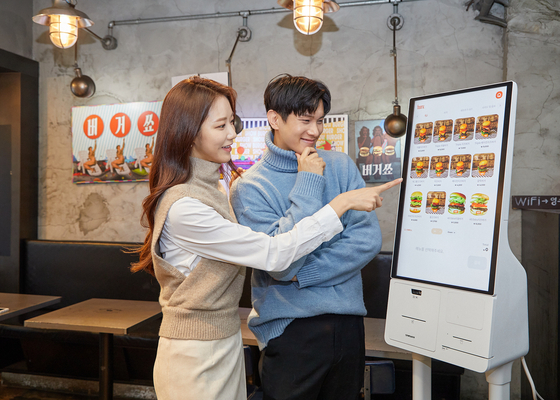These days, when you go to a fast food restaurant or cafe, the scene of ordering food has changed a lot. Instead of a person, a’kiosk’ (a touch screen-type unmanned terminal) processes orders and even pays.
After choosing the product you want on the kiosk screen, paying by credit card or mobile, receive a number tag, and sit down, the ordered food will be served. Store owners do not have to hire staff to receive orders, so they can save labor costs, and users can reduce waiting time for orders or payments.
According to the industry on the 22nd, the domestic kiosk sales this year is expected to reach 30,000 units. What was at the level of 10,000 in 2018, jumped to 20,000 last year, and predicted a 50% growth this year. It means that 82 units are installed a day. In terms of amount, it is worth 300 billion won.
![I'm browsing the menu with a kiosk to order food at a hamburger shop. [사진 삼성전자]](https://i0.wp.com/pds.joins.com/news/component/htmlphoto_mmdata/202102/22/b92ce404-e19b-4ebc-8bac-9d6ca7a07b3f.jpg?w=560&ssl=1)
I’m browsing the menu with a kiosk to order food at a hamburger shop. [사진 삼성전자]
Kiosk interest as the minimum wage rises
The kiosk has gained full-scale attention in the market since the minimum wage in 2018 jumped. The minimum wage at the time was 7530 won, up 16.3% from the previous year. In 2019, it was decided at 8350 won, 10.8% higher than the previous year. Kwon Kang-soo, director of the Korea Startup Real Estate Information Service, explained, “Regardless of the type of business, labor costs account for about 20% of store sales. When considering starting a business, stores will be interested in introducing an unmanned payment system, a kiosk.” Director Kwon added, “In addition, the small burden of money is also a factor in the growth of the market as it is possible to pay in installments through leasing or capital.”
As the non-face-to-face culture spread in the aftermath of the novel coronavirus infection (Corona 19) last year, kiosk sales gained wings. As sales fell as fewer people visited offline stores, hiring employees became more burdensome for store owners. It also has the advantage of minimizing contact between customers and employees visiting the store.
There have also been changes in the kiosk market, which has been centered on mid-sized and small and medium-sized businesses. Currently, the representative kiosk companies in Korea are Hanasys C, I-Tech, and BT One. Most of them are annual sales of 10 to 40 billion won. Large companies such as Samsung Electronics and CJ OliveNetworks are also jumping into this market.
On the 17th, Samsung Electronics launched’Samsung Kiosk’, an order solution that can handle both orders and payments in Korea. In the first half of this year, it is scheduled to be introduced in Asia and Australia sequentially. There are largely a table type, a stand type, and a wall-mounted type. Ha Hye-seung, executive director of Samsung Electronics’ video display division, said, “We emphasized hygiene by applying a special coating that has an antibacterial effect of 99.99% or more on the touch screen.”
![Ordering from a kiosk at a cafe. [사진 CJ올리브네트웍스]](https://i0.wp.com/pds.joins.com/news/component/htmlphoto_mmdata/202102/22/618b5e65-38c2-4450-a3fc-6c67f04d8ae1.jpg?w=560&ssl=1)
Ordering from a kiosk at a cafe. [사진 CJ올리브네트웍스]
Expected to sell 30,000 units this year… Samsung and CJ also advanced
CJ OliveNetworks announced on the day that it will apply’One Order’ to Paul Bassett, a coffee specialty store. It is a system that enables orders, employee calls, and payments through kiosks and mobile/tablet PCs.
Kiosks, which have been generally applied to restaurants and cafes, are expanding to the telecommunications industry. LG U+ has introduced’U+ Kiosk’ to about 30 major stores nationwide. You can open your own cell phone or handle communication tasks such as bill inquiry and payment. In the first half of this year, it plans to open an unmanned store near Gwanghwamun, Seoul, with only a kiosk without staff. SK Telecom also introduced a’self kiosk’ that allows you to purchase smartphones 24 hours a day.
Bae-seung Jeon, an analyst at Ebest Securities, said, “Since Corona 19, the digital financial environment is rapidly changing due to the expansion of online consumption and non-face-to-face payment. The growth of the kiosk market shows a paradigm shift in the payment market.”
Reporter Choi Hyun-joo [email protected]
